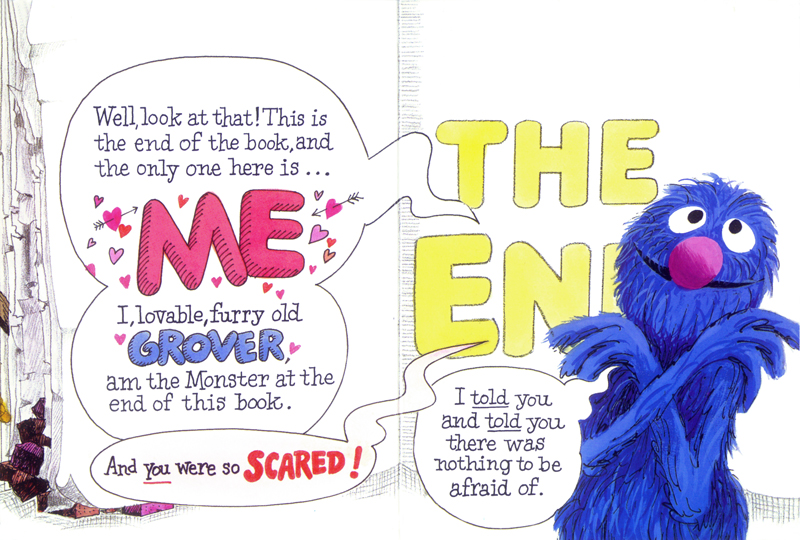On the cover of The Monster at the End of This Book Starring Lovable, Furry Old Grover, Grover breaks the narrative fourth wall and smiles and waves at the readers, a bit shyly, saying “Hello, everybodeee!” No mistaking that voice! Then the title page, which readers always turn past quickly, like Grover, who is already peeling back one corner of the illustrated page (drawn on the real paper), saying, “This is a very dull page. What is on the next page?”

It is only then that the title of the book sinks in. “WHAT DID THAT SAY?” demands Grover. The lovable muppet is standing before a large blank book; all words and images exist at Grover’s level, somewhere between the drawn book and the real paper). “On the first page, what did that say? Did that say there will be a Monster at the end of this book??? IT DID? Oh, I am so scared of Monsters!!!”
On the next leaf Grover is lying on the floor in front of the blank book with a furry, blue finger in front of his mouth. “SHHHH Listen, I have an idea. If you do not turn any pages, we will never get to the end of this book. And that is good, because there is a Monster at the end of this book. So please do not turn the page.”
Well, what are you going to do? At least stop to think about it before you turn another page. If lovable, furry old Grover asked you to do something, you would do it, right? Right? Are you going to stop reading as your childhood friend requested or keep turning pages against his explicit wishes? It is up to you.

Of course, you keep turning pages, no matter how much you upset Grover, no matter how much he pleads with you, no matter how often he screams in big, orange letters, “YOU TURNED THE PAGE”
He ties the pages down with ropes, but we know the ropes are drawings and so we turn the page again. If we didn’t, Grover would remain frozen in place. We love Grover and we want to see him in action, especially if there he is going to confront a monster. Grover nails the page down with boards. No problem. Grover complains, “Do you know that every time you turn another page,” and he peevishly adds, “you not only get us closer to the Monster at the end of this book, but you make a terrible mess!” That makes us laugh, because, for once, we are not making any messes, but quietly reading a book. Grover builds a brick wall, and we demolish it with a flick of a thumb. We love Grover, but we go on reading because we want to find out what will happen. Grover, covered in bricks says in very small letters, “Do you know that you are very strong?”
You are strong. You have the God-like power of a reader, recreating the world of the book as you read. You make the characters live by running your eyes across the images and letters, by “playing the book,” much as you might play a CD. On the second to last page, Grover says PLEASE four times in big colorful letters with his hands clasped in front of him. Will you insist on continuing? Will you? Are you some kind of sadist?
Yes, you are a reader and a reader wants the characters to suffer, otherwise there would be no drama, no excitement. And you must keep reading if the action is to continue. You could close the book forever and put it away. But then we would never find out about the monster at the end of the book, and let’s face it, we want to find out about the monster! And closing the book would kill Grover, consign him to silence. If you stop reading, the book stops, the characters stop. A closed book is inert code without life or meaning.
On the last page — the page with the monster–we see no one but Grover. “Well, look at that! This is the end of the book, and the only one here is . . . ME. I, lovable, furry old GROVER am the monster at the end of this book.” Grover realizes and embraces his monstrosity, an important lesson for any child (the monsters).

Grover is mistaken, however, he is not the only one there. You are there too, gentle reader. Grover even addresses you: “And you were so SCARED! I told you and told you there was nothing to be afraid of.”
Nothing to be afraid of? No, you are all right, Grover, since you have embraced your monstrous nature. But what about the other being there at the end of the book? The one Grover should be afraid of.
You, the reader. You are the one who put him through all that agony, when he begged and begged and begged you to stop. Did you listen? No! You are the one that demands conflict and suspense. You are one that tortured lovable, furry old Grover.
Just look at him! You monster, you reader!
(Check out other metafiction for children: The World’s Shortest Novel? Snoopy’s “It Was a Dark And Stormy Night”, A Nightmare Reading of Harold and the Purple Crayon, and The Limits of Language: Seuss Beyond Zebra. To read more about the important role of the reader, read my book Narrative Madness, available at narrativemadness.com or on Amazon.)
Stone, John. The Monster at the End of This Book Starring Lovable, Furry Old Grover. Illus. Mike Smollin. Racine: Western Publishing Company, 1971.
Such and amazing fun book to read with Toddlers. I think this book, read with lots of expression, helped my grandson learned to speak, read, express himself through inflection, and show emotions… Love it!
And love the way you shared this amazing story!